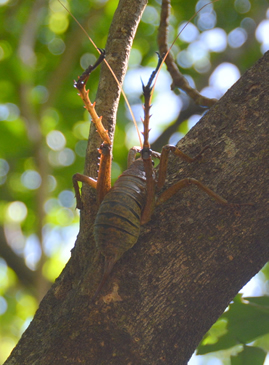• Logbook
• Where are we?
Photo album:
• Auckland & region
Recommended services:
• Mangawhai Heads Holiday Park
Did you find our website useful?
THANK YOU!
Leg breakdown:
Date Activity Leg Distance (Km) Elev. Gain (m) Elev. Desc. (m) GPX Profile 4-Nov-18 Hike Ride Hike on Tiritiri Matangi Island and ride from Gulf Harbour to Orewa 15.5 119 119 GPX Profile 5-Nov-18 Ride Orewa to Matakana 57.6 605 607 GPX Profile 6-Nov-18 Ride Matakana to Mangawhai Heads 58.6 541 540 GPX Profile
1-6 November, 2018: Auckland and region
After 14 hours of flight, we approach the Auckland airport. Through the window we can see what we already expected: it rains, not even a small ray of sunshine. We hoped for a miracle, but miracles don’t exist. After landing, the customs process is thorough but friendly. New Zealanders are very concerned about visitors not importing non-native plant or animal species. We were already ready for their requirements: new tires on the bikes, an almost new and clean tent and clean boots. Everything is ok, so they give us the go-ahead without further problems.
Here is the first reality fact. Outside, besides the rain, it’s windy. At the exit of the airport there is a space reserved for assembling bikes, even with a bike stand. But the wind blows the rain laterally and all the gear will get wet in the process. We are not psychologically ready to land and start getting wet. Surely there will be other occasions. So, we get on a shuttle with a convenient baggage trailer that distributes travelers around the city. We arrive at our AirBnB comfortably and dry.
The second reality fact is the friendliness of the New Zealanders. The owner of the AirBnB receives us with a big smile and gives us all sorts of information, such as details of how to go to the city center, services in the surroundings, typical places to visit, etc., etc. The third reality fact is that they couldn’t care less about rain, wind or cold. All those explanations and details were given under the rain before showing us the cottage where we will stay for the next 3 days.
Auckland is a modern city in full growth. The business area, around the harbor, is in full expansion with new buildings in construction everywhere. The neighborhoods around downtown are clustered in the multiple hills that make up the city and usually occupied by single family houses or low buildings. The most emblematic neighborhoods preserve Victorian houses with manicured gardens. In the 3 days that we visit the city we realize of the great number of urban parks and the incredible amount of bike lanes, both dedicated and shared with cars. The car lanes, however, are narrower than the San Diego ones and the drivers are less careful with cyclists.
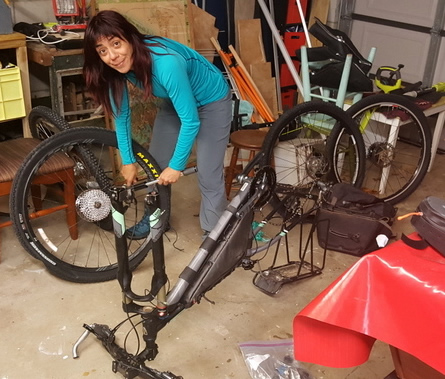 Attached to our cottage is the owner’s garage, where we are allowed to assemble the bikes. During the transport on the plane, Cèsar’s front wheel disc rotor is warped and the wheel is not true anymore. Judit's bike rear shifter is not working properly either. With our few tools we fix the issues somewhat but not enough to start the trip, so we take them to a bike shop. Summer is around the corner here along with the Christmas holidays. At this time of the year, there is an explosion of outdoor activities, the city is deserted, and everybody is getting ready for it. As a result, all the bike shops are extremely busy and after checking five different places, we have to start begging to get our bike problems fixed the same day. The guys at Torpedo 7 makes us the favor and do a good job on the spot.
Attached to our cottage is the owner’s garage, where we are allowed to assemble the bikes. During the transport on the plane, Cèsar’s front wheel disc rotor is warped and the wheel is not true anymore. Judit's bike rear shifter is not working properly either. With our few tools we fix the issues somewhat but not enough to start the trip, so we take them to a bike shop. Summer is around the corner here along with the Christmas holidays. At this time of the year, there is an explosion of outdoor activities, the city is deserted, and everybody is getting ready for it. As a result, all the bike shops are extremely busy and after checking five different places, we have to start begging to get our bike problems fixed the same day. The guys at Torpedo 7 makes us the favor and do a good job on the spot.
We start riding the following morning. To avoid the traffic of Auckland’s suburbs, we take the ferry that goes to the Tiritiri Matanga Island Scientific Reservation, a bird sanctuary. On the way back, we'll get off at Gulf Harbor, instead of returning to Auckland, like the rest of the passengers, and start our ride there. The visit to the island optionally includes a guided tour by ornithologist-wanna-be volunteers, who are very helpful in identifying the different species of birds and insects.
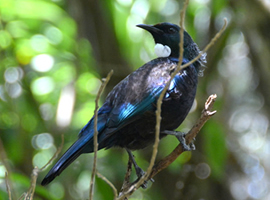
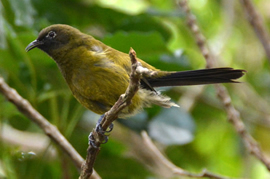
Many of the creatures here are a bit odd: the New Zealand pigeon is the size of a chicken, the Tui has a white untidy feather in the chest as a bow tie, the Weta is a kind of cricket measuring 10 cm that lifts its hind spiky legs to scare away predators. At the end of the route we reach the island's lighthouse where another volunteer tells us the history of the place. In short, a very pleasant visit that serves as a perfect introduction to the country's wildlife.
We get off at Gulf Harbor and start pedaling. Pedaling should be easy, right? Well, it’s not. Momentum is the culprit. The handlebar does not want to turn because of the weight of the front bag hanging from it, and when it finally does, it turns too much. So much that it makes the rear paniers wobble, which we try to counterbalance with swerving the handlebar. The perfect example of a positive feedback system. Our ride has quite a rhythm. We stop every 100 m to adjust this, adjust that, check that clicking noise, the dynamo does not charge, we have not put on sunscreen, now I'm cold, now I'm sweating, etcetera, etcetera, etcetera. Luckily, our goal for today is only 15 km away.
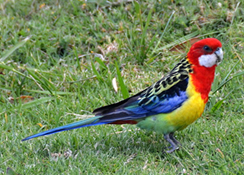
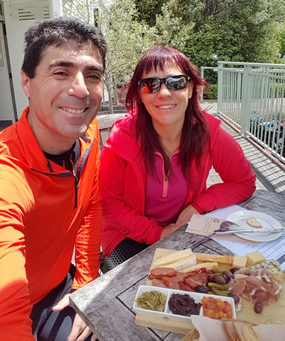 In the next two days we continue North but avoiding the main roads. The back roads take us through rural areas dedicated mainly to farming. There are green pastures everywhere, delimited by native forest only in those areas where human activity has not yet destroyed it. The terrain is very hilly, and we spent the whole day going up and down. Cows and sheep look at us patiently as we climb the slopes. Conveniently, we arrive to Puhoi at lunchtime. We stop at the cheese factory to certify that its fame is well deserved. Delicious!
In the next two days we continue North but avoiding the main roads. The back roads take us through rural areas dedicated mainly to farming. There are green pastures everywhere, delimited by native forest only in those areas where human activity has not yet destroyed it. The terrain is very hilly, and we spent the whole day going up and down. Cows and sheep look at us patiently as we climb the slopes. Conveniently, we arrive to Puhoi at lunchtime. We stop at the cheese factory to certify that its fame is well deserved. Delicious!
One of the nights we end up camping in a place that seems half campground and half farm. At night, the lady in charge brings us 10 fresh eggs. Yes, here the egg boxes contain 10, not 12 eggs. At dawn the roosters wake us up much earlier than we would have liked but we retaliate with some scrambled eggs from their harem. The next night we stop at a spectacular campsite, right on the beachfront, on a manicured lawn overlooking the bay of Mangawhai Heads. A perfect end for the day.
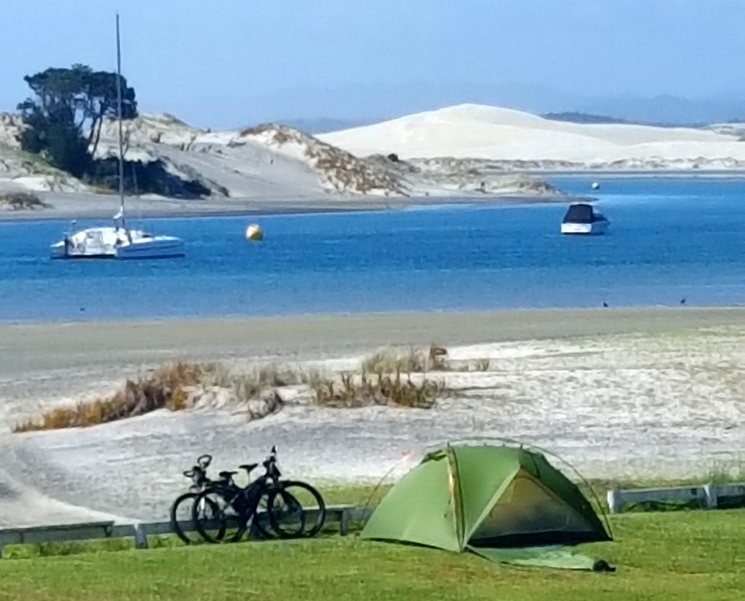
© 2018 Explore Pangea. All Rights Reserved. Website Terms of Use.
